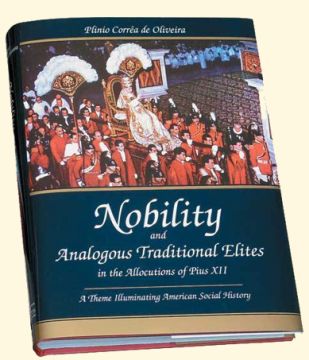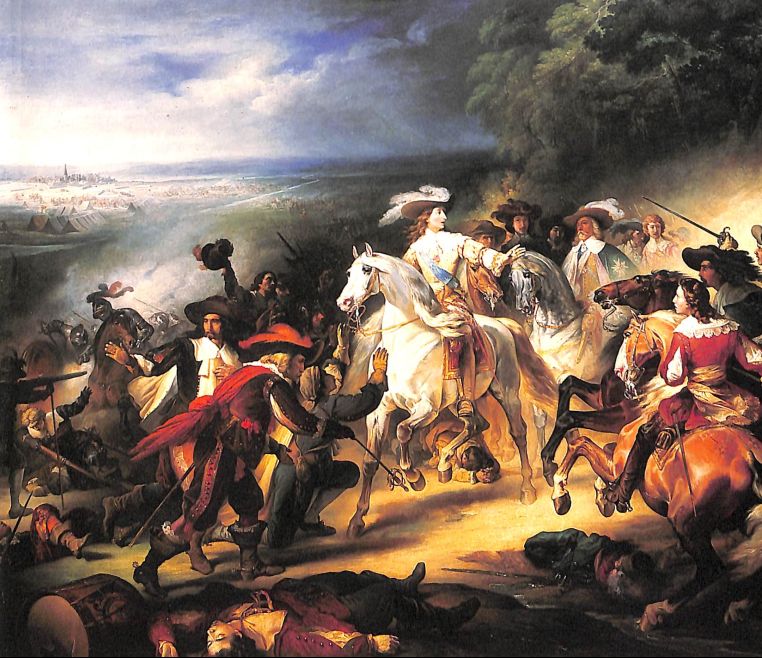|
Plinio Corrêa de Oliveira
Chapter VII
7. The Moral Profile of the Medieval Noble
|
|
|
The Battle of Rocroy. The victorious Prince of Condé shows clemency to the heroic defeated army. In every social body constituted by professionals in the same field, we easily notice how much the profession influences the mentality and the intellectual and moral profile of its members, and, consequently, the domestic and social relationships extrinsic to their professional sphere. In the Middle Ages and the Ancien Régime, the condition of a noble could not be equated to a mere profession. In a sense, it was a livelihood, but it was also much more. Consequently, it profoundly marked the noble and his family, through which the noble condition was to be transmitted to future generations. The title was incorporated into the family’s name and sometimes subsumed it. The coat of arms was the family’s emblem. And the land over which the noble exercised his power usually bore his own name, and when it did not, its name was incorporated into his title.142 a. In war as in peace, the example of perfection Two essential principles defined the physiognomy of the noble: 1. In order to be the exemplary man placed at the summit of the fief as the light atop a chandelier, the noble had to be, by definition, a Christian hero disposed to endure any sacrifice on behalf of the good of his king and his people. He had to be the armed defender of the Faith and Christendom in the frequent wars against pagans and heretics. 2. In every field, he and his family had to give a good example—or better, an excellent example—to their subordinates and peers. In virtue as in culture, manners, taste, the decoration of the home, and celebrations, their example had to motivate the whole social body so that everyone would improve in every field. b. The Christian gentleman and the Christian lady These two principles had an admirable practical scope, as we shall see. During the Middle Ages, they were lived with authenticity of conviction and religious sentiment. In this manner, the physiognomy of the Christian gentleman and the Christian lady appeared in European and, later, in Western culture. Gentleman and lady: two concepts that, throughout the ages and despite the successive dilutions inflicted by the gradual secularization in the Old Regime, always designated the excellence of a human standard. Even in our time, in which both titles have lamentably become obsolete, they nevertheless continue to designate this excellence. Even when the nobility lost everything we mentioned, not only in Italy (which Pius XII had particularly in mind) but in other countries as well, its elevated human standard remained. This standard, the supreme and last treasure of the nobility, cannot be fully understood without taking into account why and how it was formed through the creative process of feudalism and the feudal hierarchy. c. Sacrifice, good manners, etiquette, and protocol—simplifications and mutilations imposed by the bourgeois world Sacrifice. The word deserves to be emphasized, for it had a central importance in the life of the noble. It was present even in his social life in the form of an ascesis that deeply marked it. Indeed, good manners, etiquette, and protocol were developed according to standards that demanded from the noble a continual repression of what is vulgar, rough, and even offensive in so many of man’s impulses. Social life was, in some aspects, a perpetual sacrifice that became more demanding as civilization progressed and refined itself. This statement may elicit a skeptical smile from some readers. However, if they wish to see how true it is, let them consider the mitigations, simplifications, and mutilations that the bourgeois world, born of the French Revolution, has gradually imposed upon the etiquette and ceremony that have survived to our days. Without exception, all these changes were introduced to offer ease, insouciance, and bourgeois comfort to the nouveaux riches bent on conserving as much as possible, in the midst of their recently-acquired opulence, the vulgarity of their previous lifestyle. Thus, the erosion of good taste, etiquette, and good manners resulted from a spirit of laissez-faire, a desire to “unwind,” and the prevalence of the spontaneous and extravagant whims of “hippieism,” which reached an apex in the unbridled rebellion of the Sorbonne in 1968 and in subsequent youth movements such as “punkism.” d. Harmonious diversity in the practice of virtues: through self-denial in the religious state; amid grandeur and splendor in temporal society At this point we should mention a trait of soul that stands out in many members of the nobility. Many saints of noble birth renounced their social condition to practice the perfection of virtue in the earthly self-denial of the religious state. How splendid were the examples they gave to Christendom and the world! Other noble saints, however, remained amid the splendors of temporal life. With the prestige of their station, they stressed in the eyes of the other social classes the magnificence of the Christian virtues, and set a good moral example to the collectivity they headed. They did this to the advantage, not only of the salvation of souls, but of temporal society too. In this sense, nothing is more beneficial to the State and society than having in its highest ranks persons shining with the sublime respectability that emanates from the saints of the Catholic Church. Moreover, these saints—so worthy of reverence and admiration because of their elevated station—were especially loved by the multitudes due to their constant and exemplary practice of Christian charity. Indeed, there are innumerable beatified and canonized nobles who, without renouncing the earthly honors of their rank, stood out for their particular love for the needy. They earnestly practiced a preferential option for the poor. Many nobles who chose the admirable self-denial of religious life also shone in this solicitous service to the needy. They became poor with the poor to lighten the earthly crosses of the destitute and prepare their souls for heaven. It would unduly prolong this work to mention the numerous nobles of both sexes who, for love of God and neighbor, practiced the Evangelical virtues amid the grandeur and splendor of temporal society, as well as those who practiced them in the self-denial of religious life.143 e. How not to govern—how to govern To govern is not only, nor principally, to make laws and penalize transgressors, compelling the population to obey by means of an extensive bureaucracy and a coercive police force. At best, one can govern a prison in this way, but not a people. As we said in the beginning of this chapter, to govern men it is first necessary to gain their admiration, confidence, and affection. This requires a profound consonance of principles, aspirations, and rejections, and a body of culture and traditions common to those governing and those governed. Feudal lords generally achieved this objective in their fiefs by continually stimulating the people toward excellence in every field. Even when trying to obtain a popular consensus in favor of wars resulting from the conditions of the time, the nobility used suasive means. In doing so it was expected to give priority to the ecclesiastical hierarchy’s preachings on the moral circumstances that might justify a war, whether for religious or temporal reasons. f. The bonum and pulchrum of just war — The knight felt it to the depths of his soul The nobility made the bonum of just war shine together with its pulchrum144 through the expressiveness of its military ceremonial, the beauty of its arms, the caparison of its horses, and so on. A noble viewed his participation in just war as an immolation for the glorification of the Church, the spreading of the Faith, and the common good of the temporal sphere. He was ordained toward this immolation, as, in an analogous way, the clergy and religious were ordained toward the spiritual immolation inherent to their respective state. Knights—who were not always nobles—felt the bonum and the pulchrum of this immolation to the depths of their souls. They went to war with this state of spirit. The beauty with which they surrounded military activity was far from a mere means of enticing plebeians into accompanying them to war. This was, however, the effect this beauty produced in the spirit of the people. (Let it be said in passing that the commoners of the time were not subject to compulsory draft.) Of course, in that age of ardent Faith, the teachings of the Church had a much greater effect upon the people than did these brilliant appearances. These teachings left no doubt about the fact that a holy war, more than being simply legitimate, could be a duty for all Christians, nobles, and plebeians alike.145 Footnotes: (142) This mutualism among man, function, and land was expressed in a touching way by Paul Claudel in The Hostage: “Coufontaine—As the earth gives us her name, so do I give her my manhood. Thanks to her we still have roots, and through me and the grace of God, she is not without seed. I am her lord. And that is why, above all others, I bear her name, her name to which the title is prefixed; the title of de! My fief lies within my kingdom as within a smaller France. The earth is of me, and my race becomes gentle-blooded and noble: a thing which cannot be bought” (In Three Plays, transl. by John Heard [Boston: John W. Luce Co., 1945], p. 18). (143) Regarding the number of nobles elevated by the Church to the honors of the altar, see Nobility and Analogous Traditional Elites, Documents XII. (144) Bonum and pulchrum, good and beauty, respectively, are used here in their philosophical senses as attributes of being. Good is that which is suitable or befitting a thing; beauty denotes that which pleases upon being seen or heard because of its integrity, proportion, and clarity. (145) The teachings of popes, saints, doctors, and theologians about the conditions for a just war can be found in Nobility and Analogous Traditional Elites, Documents XI. |
|


